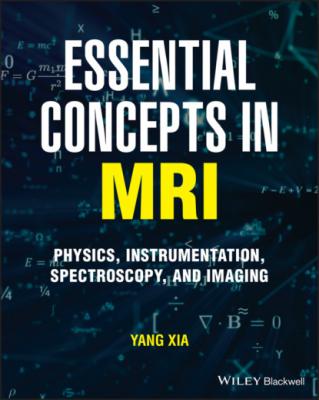Essential Concepts in MRI. Yang Xia
Читать онлайн.| Название | Essential Concepts in MRI |
|---|---|
| Автор произведения | Yang Xia |
| Жанр | Медицина |
| Серия | |
| Издательство | Медицина |
| Год выпуска | 0 |
| isbn | 9781119798248 |
where Tr represents the trace of the matrix (the sum of the diagonal elements) – see Eqs. (A2.32) and (A2.33), and the two examples at the end of Appendix A2.6. The term in brackets describes the degree of “single quantum coherence” of the ensemble, while the average (the bars) reflects the phase coherence between the +1/2 and –1/2 states. At thermal equilibrium, both a1/2*a−1/2¯ and a1/2a−1/2*¯ are zero (no transverse component), while the term (|a1/2|2¯−|a−1/2|2¯) has a stable value (the longitudinal magnetization along the z axis).
3.5 MACROSCOPIC MAGNETIZATION FOR SPIN 1/2
In the current context, the observable quantity is just the (macroscopic) magnetization M, given by
where N is the number of spins, and i, j, and k are the unit vectors in the Cartesian coordinates. Equation (3.17) is important because it may be shown that any state of the density matrix (defined in Appendix A2.6) for an ensemble of non-interacting spin-1/2 particles can be described using the macroscopic magnetization defined in this manner, thus permitting a classical description of simple spin systems.
In the absence of an external magnetic field, the ensemble average of the magnetization vector should be zero due to the random directions of the magnetic dipoles of the nuclei.
If a sample is immersed in an external field and in thermal equilibrium, the density operator associated with this magnetization vector is given by
The transverse component of M is zero due to the even distribution of the azimuthal phase angles of the precessing nuclei in the transverse plane. This corresponds to phase incoherence leading to the zero value of the off-diagonal elements of ρ,
The z component of the magnetization M arises from the difference in populations between the upper and lower energy states. At room temperature, the magnitude of this magnetization in the equilibrium state, M0, can be derived as
For a spin-1/2 system at room temperature, the population difference between the spin-up (m=+1/2) state and the spin-down (m=−1/2) state can be calculated from the diagonal elements of ρ, as
For protons at B0 = 1.4 T (60 MHz), it is equal to about 5 × 10-6, a small value resulting from the small value of γħB0 (Zeeman splitting) compared to kBT (Boltzmann energy). It is this small magnetization of nuclei at room temperature that limits NMR detection sensitivity and leads to resolution limitations in MRI experiments [7, 8].
3.6 RESONANT EXCITATION
When both B0 and B1(t) are present and perpendicular to each other (B1 in the transverse plane), we can write down the Hamiltonian in the laboratory frame as
In the rotating frame, the Hamiltonian becomes
At ω = ω0, we have
Since Ix=12(I++I−), where I+ and I- are the raising and lowering operators defined in Appendix A2.4, the time evolution of the spin system corresponds to an inter-conversion of each spin between |1/2> and |–1/2> at a rate of γB1 (an oscillation).
3.7 MECHANISMS OF SPIN RELAXATION
Spin relaxation is truly fundamental and central to the theory of NMR and MRI; the influence of spin relaxation on both NMR and MRI measurements is wide, deep, and quite often subtle. It is therefore worth taking some time to learn to appreciate the subtleties of spin relaxation.
A nucleus in a liquid experiences a fluctuating field, due to the magnetic moments of nuclei in other molecules as they undergo
